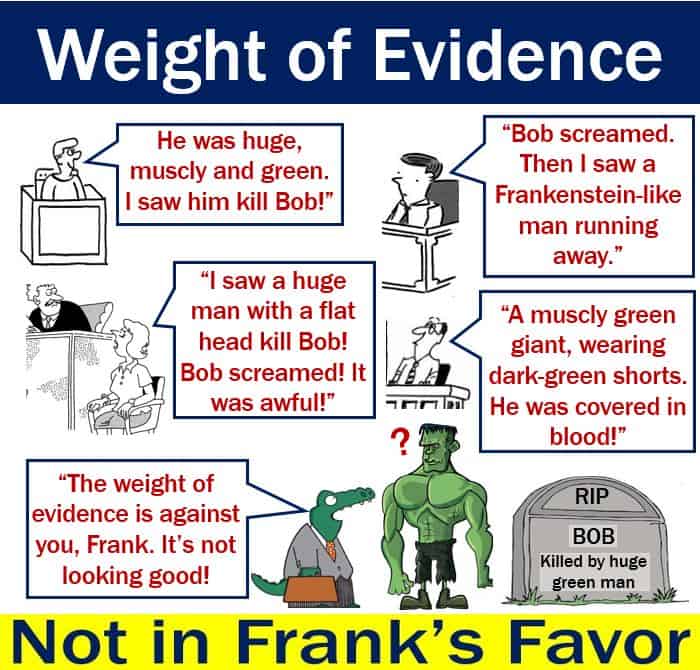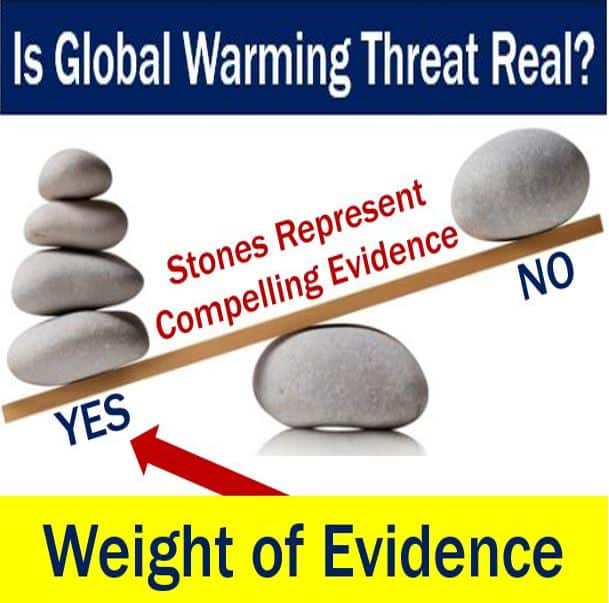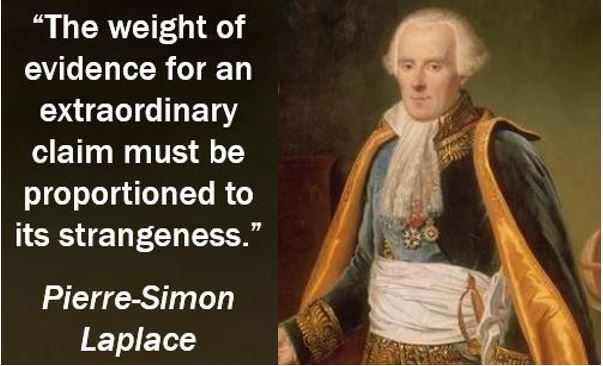Weight of evidence – definition and meaning
Weight of evidence, also known as WoE or WofE, when measuring evidence on more than one side of an issue, is a measure of evidence on one of those sides versus the evidence on the other side. The term is also used when measuring the evidence on more than two issues.
Sometimes the term refers to the strength of one single piece of evidence. At other times, weight of evidence may refer to the whole set of evidence presented on a subject, such that overall it is clearly favoring one side or the other.
Weight of evidence may be used in mathematics, science, policy-making, statistics, information theory, psychology, the law and courts, and business.
 Frank, the giant, muscly, green man with a flat head, wearing dark green shorts, has no alibi. Several witnesses either saw him kill Bob, or witnessed him running away from the scene covered in blood. The weight of evidence is overwhelmingly against him.
Frank, the giant, muscly, green man with a flat head, wearing dark green shorts, has no alibi. Several witnesses either saw him kill Bob, or witnessed him running away from the scene covered in blood. The weight of evidence is overwhelmingly against him.
Weight of evidence – Law and courts
Weight of evidence is based on how credible and persuasive the evidence is. The tendency to convince people of the truth regarding some proposition depends on the persuasiveness – how compelling the proof is – rather than the number of witnesses.
For example, one witness may give uncorroborated but apparently sincere and honest testimony that people are inclined to believe, even though a number of apparently respectable witnesses may contradict him or her.
For the jury, the question is not who has the most witnesses, but rather what testimony they find the most credible and persuasive.
Regarding weight of evidence, Legal-Dictionary.TheFreeDictionary.com writes:
“Evidence that is indefinite, vague, or improbable will be given less weight than evidence that is direct and unrefuted. For example, a criminal defendant’s testimony that he had never been at the scene of a crime would be given little weight if his fingerprints were found at the crime scene and witnesses testify they saw him at the scene.”
“Similarly, evidence given by a witness who testifies from personal observation is of greater weight than evidence offered by a witness who is testifying from general knowledge alone.”
 According to the Union of Concerned Scientists: “[We need] to educate the public about the overwhelming weight of the scientific evidence for human-caused global warming.”
According to the Union of Concerned Scientists: “[We need] to educate the public about the overwhelming weight of the scientific evidence for human-caused global warming.”
Weight of evidence in science
In an article published in Risk Analysis in December 2005 – ‘Weight of Evidence: A Review of Concept and Methods’ – Douglas L. Weed, from the National Cancer Institute in Rockville, Maryland, USA, wrote that ‘weight of evidence’ is a common term in published scientific literature, as well as policy-making texts – most frequently seen in the context of risk assessment.
Weed added, however, that the term’s definition was unclear. He searched through publications in PubMed from 1994 to 2004 for articles where ‘weight of evidence’ appeared either in the abstract or title.
He found that the term had three characteristic uses in literature:
– Metaphorical: where ‘weight of evidence’ referred to a collection of studies or to a methodological approach that had not been specified.
– Methodical:, where ‘weight of evidence’ pointed to established interpretative methodologies, or where the term meant that ‘all’ rather than some subset of the term was examined. Less frequently, the term was also used where methods using quantitative weights for evidence were used.
– Theoretical: where the term served as a label for a conceptual framework.
 Pierre-Simon, marquis de Laplace (1749-1827) was an influential French scholar whose work was important in the development of physics, statistics, mathematics and astronomy. He is remembered as one of the greatest scientists of all time – sometimes referred to as the ‘Newton of France’. (Image: adapted from Wikipedia)
Pierre-Simon, marquis de Laplace (1749-1827) was an influential French scholar whose work was important in the development of physics, statistics, mathematics and astronomy. He is remembered as one of the greatest scientists of all time – sometimes referred to as the ‘Newton of France’. (Image: adapted from Wikipedia)
Weed identified several problems, including
- the frequent lack of definition of the term,
- its multiple uses, and
- a lack of consensus regarding its meaning.
He found that there were many different types of weights, both quantitative and qualitative, which were used in risk assessment.
He recommended that the ‘weight of evidence’ concept and its associated methods should be fully described when used.
At the end of an Abstract preceding the main article, Weed wrote:
“A research agenda should examine the advantages of quantitative versus qualitative weighting schemes, how best to improve existing methods, and how best to combine those methods (e.g., epidemiology’s causal criteria with toxicology’s quality criteria).”

